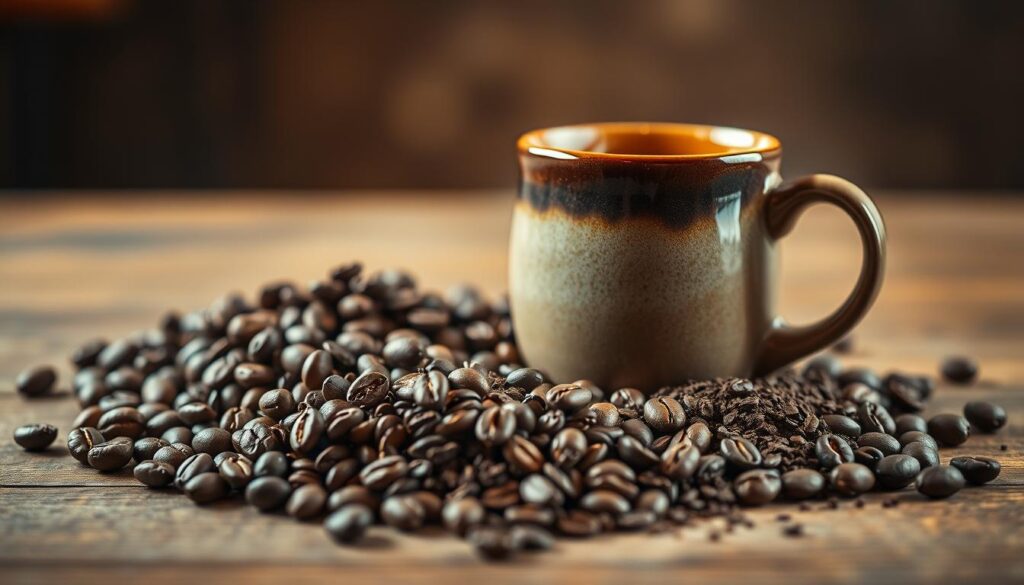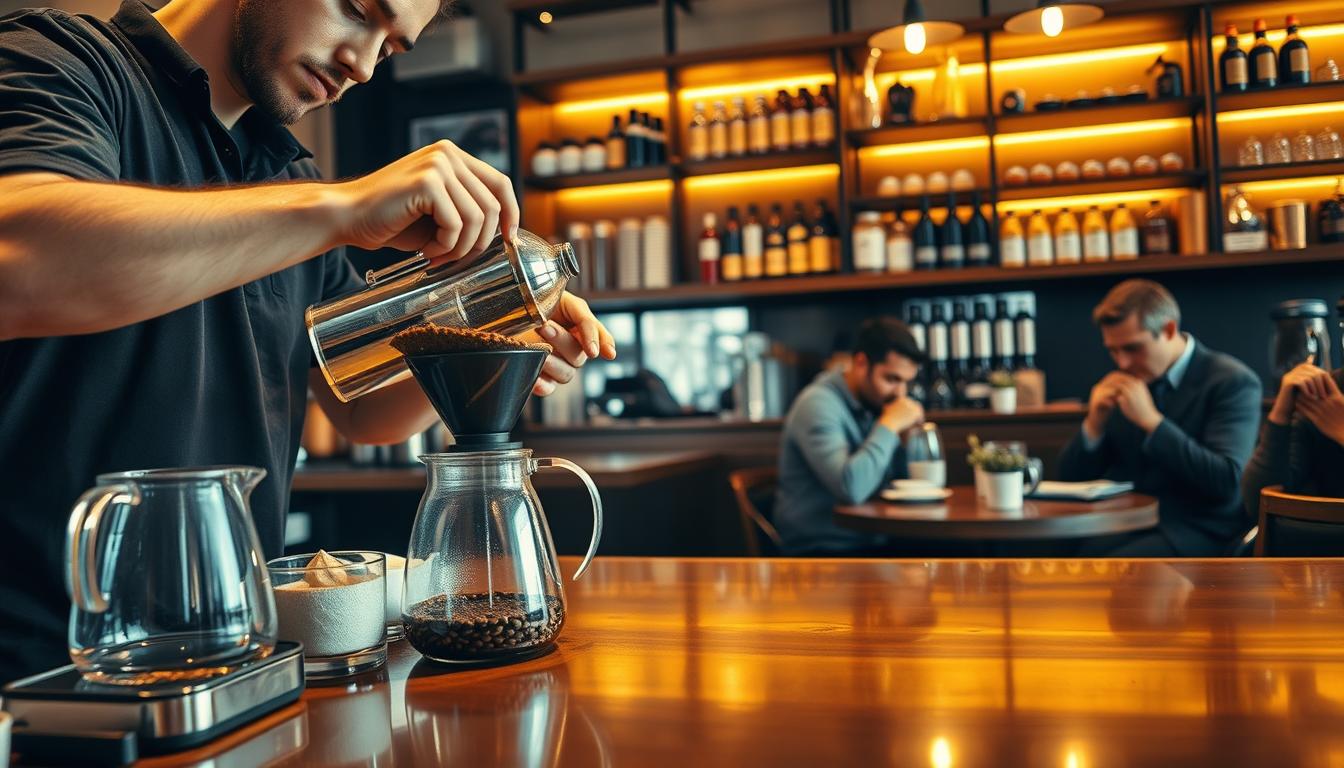Did you know 64% of daily drinkers can’t identify the difference between a light and dark roast? This beloved beverage holds hidden layers of flavor most people never experience. But with a few simple tweaks, your morning ritual could rival the best cafes.
Your journey starts with understanding how those humble beans transform into something extraordinary. From Ethiopian highlands to modern kitchens, centuries of tradition shape every sip. It’s not just about caffeine – it’s about unlocking richness you’ve been missing.
Grind size matters more than you think. Too fine, and bitterness takes over. Too coarse, and flavors stay trapped. Water temperature plays detective, extracting hidden notes without scorching delicate oils. Even the pour speed changes the game.
Ready to become your own barista? We’ll break down exactly how professionals craft that perfect balance of aroma and depth. No fancy gear required – just smart techniques anyone can master.
Key Takeaways
- Bean selection impacts flavor more than brewing gadgets
- Water temperature should stay between 195°F and 205°F
- Grind consistency determines extraction quality
- Brew time affects bitterness versus sweetness balance
- Freshness matters – whole beans last longer than pre-ground
Introduction: Unlock the Secrets of Coffee
Your daily cup is more than just a caffeine fix—it’s a chemical masterpiece. That 95 mg energy boost you get from an 8-ounce pour? It’s powered by over 1,000 compounds working together. Farmers, roasters, and even your grinder choices shape what ends up in your mug.
Why does your homemade brew taste different from café versions? It’s all about four key factors:
| Factor | Coffee Shop | Home Brew |
|---|---|---|
| Bean Selection | Single-origin specialty | Blends (usually) |
| Roast Timing | Precision-dated | Generic “best by” labels |
| Grind Consistency | Commercial-grade | Home grinder variations |
| Water Control | Filtered & measured | Tap water (often) |
“The magic happens when you treat brewing as both art and science,”
Those crimson coffee cherries transform through drying, milling, and roasting before reaching you. Light roasts keep more origin flavors intact, while dark ones develop smoky notes. Your grind size acts like a flavor gatekeeper—fine particles release oils faster than coarse ones.
Here’s the kicker: freshness degrades 70% faster with pre-ground beans. Whole beans stored in airtight containers preserve those delicate citrus or chocolate undertakes you love. Become a brewing detective—experiment with ratios and temperatures to uncover hidden depths in every sip.
A Journey Through Coffee History
Your morning ritual connects you to a 600-year-old story that shaped civilizations. That steaming cup holds echoes of ancient traditions, daring traders, and cultural revolutions.
From Yemen to the World
Fifteenth-century Sufi mystics in Yemen perfected roasting techniques still used today. They brewed the energizing drink to fuel nighttime prayers, creating the first modern preparation methods. By 1554, Constantinople’s coffee houses became social hubs where ideas flowed as freely as the dark, aromatic beverage.
Legendary Origins and Cultural Roots
The tale of Ethiopian herder Kaldi’s energetic goats might be folklore, but it reveals our timeless fascination with these magical beans. Wild plants from Ethiopia’s highlands traveled through Somali traders to Yemeni ports, launching a global phenomenon.
European sailors later carried beans worldwide, planting them in colonies from Java to Brazil. Each region developed unique brewing traditions – from Turkish cezves to Italian espresso machines. Your daily brew literally contains centuries of human ingenuity.
“Every sip is a passport to history.”
By 1700, London had more coffee houses than taverns. These spaces birthed stock exchanges, newspapers, and political movements. Today’s café culture continues this legacy of connection and creativity.
Understanding Coffee Bean Varieties
Your bean choice shapes your entire drinking experience. Two main types dominate global production, each offering distinct characteristics that affect flavor, cost, and caffeine content.
Arabica vs. Robusta: Key Differences
Arabica beans rule 75% of the market for good reason. They thrive in high-altitude regions like Ethiopia’s mountains, producing nuanced flavors ranging from berry-like sweetness to caramel undertones. These delicate plants demand precise temperatures (60-75°F) and shaded growing conditions.
| Characteristic | Arabica | Robusta |
|---|---|---|
| Flavor Profile | Complex, fruity notes | Bold, earthy tones |
| Caffeine Content | 1.2-1.5% | 2.2-2.7% |
| Growing Conditions | Temperature-sensitive | Heat-resistant |
| Common Uses | Specialty drinks | Espresso blends |
Robusta plants laugh at harsh weather. They survive in sweltering 97°F climates while resisting pests that destroy Arabica crops. This hardiness makes them cheaper to grow, though their flavor tends toward bitterness with a thicker mouthfeel.
“Robusta’s high caffeine acts as natural pest control – it’s nature’s insurance policy.”
Need a morning jolt? Robusta packs nearly double the caffeine punch. Prefer sipping subtle tasting notes? Arabica’s your type. Most instant blends use Robusta for its affordability and crema-enhancing properties.
Your decision boils down to priorities: nuanced taste versus budget-friendly energy. Now that you know the types, you can shop labels like a pro.
The Art of Coffee Roasting
Green beans hold untapped potential until heat works its magic. Roasting unlocks over 800 aromatic compounds, turning bland seeds into flavor powerhouses. Master this process, and you control your brew’s personality.
Roast Levels Explained
Think of roast levels as volume knobs for taste. Light roasts stop after the first “crack” sound at 350-400°F. They preserve natural acidity and floral notes, letting origin characteristics shine through. Medium roasts reach 410-430°F, balancing caramelized sugars with the bean’s original flavor profile.
| Roast Type | Temperature | Flavor | Caffeine |
|---|---|---|---|
| Light | 350-400°F | Bright, fruity | Highest |
| Medium | 410-430°F | Balanced, sweet | Moderate |
| Dark | 440-500°F | Smoky, bold | Lowest |
Impact on Flavor and Caffeine
Longer roasting times break down caffeine molecules. That’s why dark roasts pack less punch than light ones despite their intense taste. Heat also transforms chlorogenic acids – lighter batches keep more, giving that tangy zing coffee enthusiasts chase.
“Roasting is time travel. Stop the heat at the right moment to visit different flavor eras.”
Prefer chocolatey richness? Choose medium-dark. Crave citrusy spark? Go light. Your perfect cup starts with understanding how roast profiles shape every sip.
Essential Brewing Techniques for a Perfect Cup
The secret to café-quality cups lies in these five techniques. Start with the golden ratio: 1-2 tablespoons of ground beans per 6 ounces of water. Adjust this base formula to suit your taste – more for bold intensity, less for subtle notes.
Your grind size acts like a flavor dial. Medium textures work best for drip machines, while coarse grinds shine in French presses. Need espresso-level richness? Go fine.
| Grind Type | Best For | Brew Time |
|---|---|---|
| Coarse | French press | 4 minutes |
| Medium | Drip machines | 5-6 minutes |
| Fine | Espresso | 25-30 seconds |
Freshness dictates flavor survival. Pre-ground beans lose vibrancy within days – whole beans stay lively for two weeks. Brew immediately after grinding for maximum aroma.
Water temperature plays double agent. 195-205°F extracts flavors without bitterness. Too hot? You’ll scorch delicate oils. Too cool? Flavors stay trapped.
“Great cups demand precision. Time your brew like you’re defusing a flavor bomb.”
Drink within 30 minutes for peak taste. Those morning batches left warming? They’re flavor ghosts of their former selves. Master these variables, and your mugs will rival any coffeehouse creation.
How to Choose Your Ideal Coffee Brew
Your perfect morning ritual begins with three key choices: origin, processing method, and freshness. Like wine grapes, beans develop distinct personalities based on where they grow. Volcanic soils in Guatemala create chocolatey undertones, while Ethiopian highlands produce floral notes.

Decoding Your Flavor Preferences
Single-origin beans tell terroir stories. Kenyan AA bursts with blackcurrant zing, while Sumatran brews offer earthy depth. Blends balance consistency – perfect if you crave the same taste daily.
| Processing Method | Flavor Profile | Best For |
|---|---|---|
| Washed | Crisp, bright acidity | Pour-over lovers |
| Natural | Fruit-forward sweetness | Cold brew enthusiasts |
| Honey | Balanced body | Espresso drinkers |
Check roast dates like expiration codes. Beans peak 7-14 days after roasting. Store them airtight – oxygen is flavor’s worst enemy. High-altitude beans (4,000+ feet) often deliver complex layers thanks to slower growth.
“Freshness isn’t a luxury – it’s the foundation of great taste.”
Start with sampler packs to explore different regions. Track which brew makes your taste buds dance. Your ideal match awaits where climate, craft, and personal preference collide.
Coffee Brewing: Tips, Methods, and Hacks
Ready to turn your kitchen into a specialty café? Mastering a few brewing methods lets you highlight different flavors in every cup. Start with the basics: 195-205°F water temperature and 1-2 tablespoons of grounds per 6 ounces of liquid.
French press fans love its bold, oily results from 4-minute steeps. Pour-over enthusiasts prefer cleaner cups using V60 or Chemex—these methods let delicate floral notes shine. Cold brew? Soak coarse grounds in cold water overnight for smooth, low-acid sips perfect for summer.
Your water quality matters more than you think. Filtered H₂O prevents mineral buildup from altering flavors. Experiment with ratios: stronger batches need more grounds, not longer brew times.
Remember these pro tips: grind beans right before brewing, and always rinse paper filters to avoid papery tastes. With these methods in your toolkit, you’ll craft barista-level drinks that surprise even the pickiest guests.

